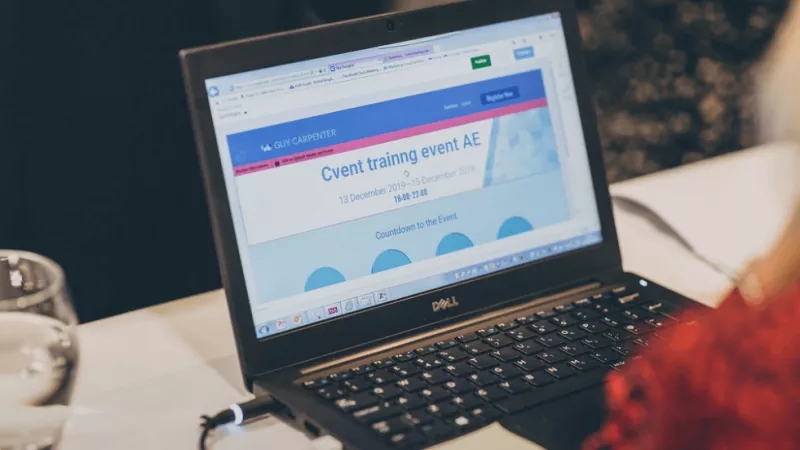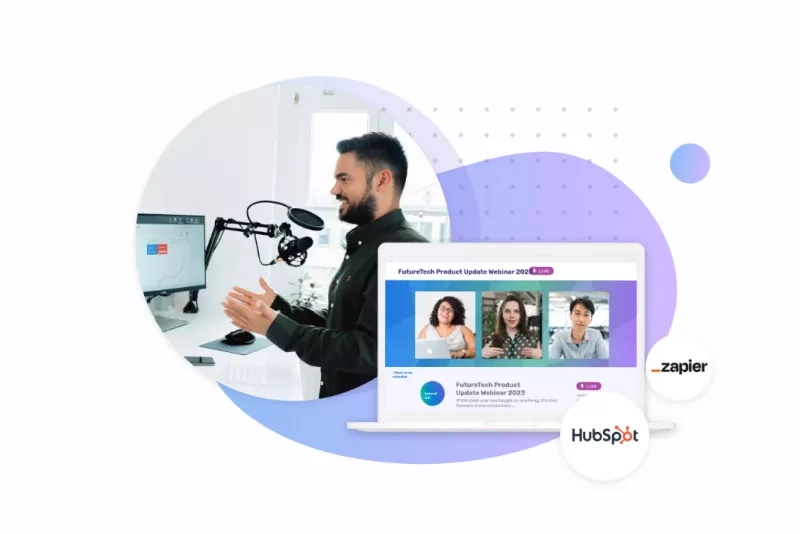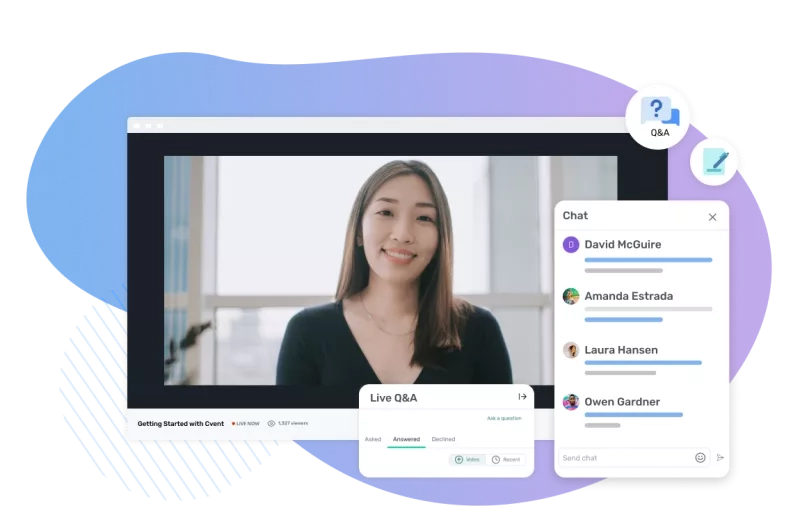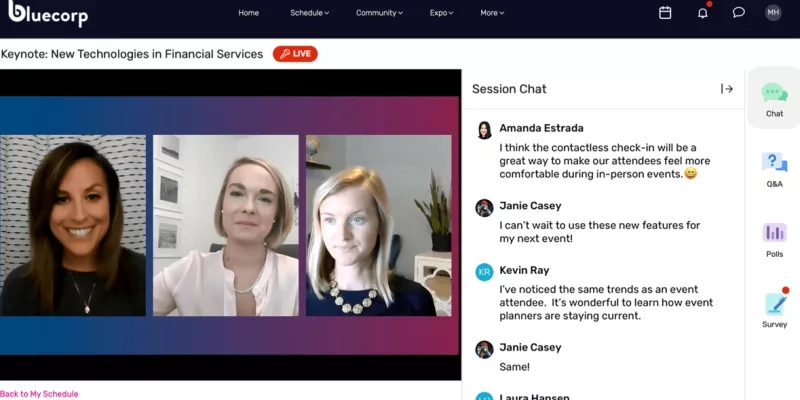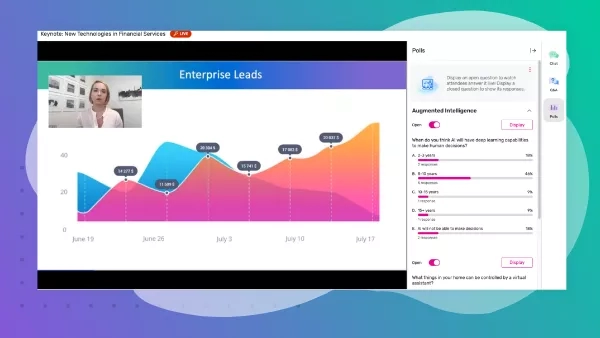Webinars are the bread and butter of savvy B2B marketers – and for good reason: 53% say they work best for mid-stage demand generation. Of course, you can't just throw any old webinar together and expect results. To move the needle, you need to get strategic with formats.
In this post, we'll break down the key types of webinars and give you the lowdown on when each style works best so you can align your webinars to your goals. Whether you want to inform, excite, convert, or engage, there's a format fit for your needs.
So, let's dive in and unlock the power of purpose-driven webinars.
Types of Webinars Based on Content Release and Availability
Webinars are a powerful tool for businesses to engage with potential customers, nurture leads, and drive sales. They can be classified into four main types based on how and when the content is released and made available:
1. On-Demand Webinars
These are pre-recorded and can be watched at any time, making them convenient for viewers who cannot attend a live webinar. On-demand webinars are also good for lead generation, as viewers must provide their contact information to access the content.
Strengths:
- Convenient for viewers: Viewers can watch the webinar at their own time and pace.
- Good for generating leads: Viewers must provide their contact information to access the content.
- Cost-effective: No need to pay for live production costs.
Weaknesses:
- Limited audience interaction: Viewers cannot ask questions in real-time.
- Can be less engaging than live webinars: Viewers may be more likely to get distracted.
2. Live Webinars
These webinars are held in real-time, with all the registrants logging in to listen to the presentation while it is happening. Live webinars allow viewers to ask questions directly to the experts. They are also a good option for product demonstrations and case studies.
Strengths:
- High audience interaction: Viewers can ask questions in real-time.
- More engaging than on-demand webinars: Viewers are more likely to be focused and engaged.
- Good for product demonstrations and case studies: Live demos and case studies can be more effective than pre-recorded ones.
Weaknesses:
- Less convenient for viewers: Viewers must attend the webinar at a specific time.
- More expensive than on-demand webinars: You might have to pay for live production costs.
- Can be difficult to scale: Reaching a large audience with a live webinar can be challenging.
3. Automated Webinars
These webinars are a combination of pre-recorded and live elements. The video is pre-recorded, but the host will select a particular time for the video to stream. This can encourage conversation, as the host can answer questions from audience members as they arise.
Strengths:
- Can be as engaging as live webinars: Use pre-recorded video and audio to create an engaging presentation.
- More convenient for viewers than live webinars: Viewers can watch the webinar at their own time.
- Can be scaled more easily than live webinars: An automated webinar can reach a larger audience.
Weaknesses:
- Can be less interactive than live webinars: Viewers cannot ask questions in real-time.
- Requires more upfront planning than on-demand webinars: Need to pre-record the video and audio.
4. Hybrid Webinars
Hybrid webinars integrate in-person and virtual components, combining diverse audiences, including physical attendees and remote participants, utilizing a web-based webinar platform. Hybrid webinars help maximize your audience reach since those who want all the benefits of in-person, such as personal discussion and networking, can seize those opportunities.
In contrast, those who want to listen online with minimum disruption to their schedule can also access that benefit. These webinars also help you grow your audience while controlling your budget, as you do not have to pay for space and food for all your potential attendees.
Strengths:
- Can reach a larger audience than any other type of webinar: Can combine in-person and virtual audiences.
- More interactive than on-demand webinars: Viewers can ask questions in real-time.
- Can be more engaging than live webinars: Viewers can benefit from in-person and virtual elements.
Weaknesses:
- Most expensive type of webinar: Need to pay for live production costs and travel expenses for in-person attendees.
- Most logistically challenging type of webinar: Need to coordinate logistics for in-person and virtual attendees.
Here is a table summarizing the key differences between the four types of webinars:
| Feature | On-demand webinars | Live webinars | Automated webinars | Hybrid webinars |
| Content availability | Pre-recorded | Live | Pre-recorded | Pre-recorded and live |
| Audience interaction | Limited | High | Moderate | High |
| Lead generation | Good | Good | Moderate | Good |
| Cost | Low | Moderate | Moderate | High |
Ultimately, the best webinar type for you will depend on your target audience and goals. Experiment with different formats and see what works best for your business.
What Are the Types of Webinars to Host?
Here’s a rundown of different types of webinar meetings and when to use them. Whether you're looking to educate, train, or promote, there's a webinar format that fits your needs at every stage of your marketing funnel.
1. eLearning Webinars
This is one of the most popular types of webinars, especially in the exploding eLearning industry. They're perfect for both live sessions and on-demand learning. So, eLearning webinars are your go-to whether you're an influencer, educator, or a company wanting to upskill employees.
These evergreen webinars work great in the awareness stage, introducing concepts and skills. Plus, they're a fantastic way for creators to earn passive income and for companies to efficiently train employees.
Characteristics:
- It can be hosted live or on-demand.
- Often evergreen, suitable for repeated viewing.
- Interactive elements like Q&A can enhance engagement.
- It is ideal for a wide range of audiences, from beginners to advanced learners.
2. Employee Training Webinars
Employee training webinars differ from eLearning webinars because they're specifically tailored for a company’s employees, often focusing on specific, internal topics. They're ideal in the consideration stage, where employees learn more about their roles or company processes. They're also a great way to train remote teams without the hassle of travel.
Characteristics:
- Usually hosted live for real-time interaction.
- Often includes practical demonstrations or case studies.
- This type of webinar can be recorded for future on-demand access by employees.
- Tailored to specific company needs and employee roles.
3. Thought Leadership Webinars
These are all about showcasing your expertise and insights into your industry. They're perfect for generating targeted leads and making new connections, and covering the latest trends and developments places you as a leader in your field. These webinars are most effective in the awareness stage, attracting a new audience with your thought-provoking content.
Characteristics:
- Best hosted live to engage with the audience in real-time.
- Often includes guest speakers or panel discussions.
- Suitable for generating leads and networking.
- Content can be repurposed for other marketing channels.
4. Product Demonstration Webinars
Launching a new product? A product demo webinar lets you dive deep into its features, showing how it solves problems. This type of webinar is especially engaging because of its interactive nature, allowing for real-time questions and answers. These are crucial in the decision-making stage, where potential customers consider buying your product.
Characteristics:
- Best conducted live for a dynamic presentation and Q&A.
- Highly interactive, encouraging audience participation.
- Ideal for the decision-making stage of the sales funnel.
- Can be technical, requiring detailed explanations.
5. Lead Nurturing Webinars
Once you've got leads, it's time to nurture them with high-level, informative webinars that showcase your expertise and unique value proposition. Think of case studies, research summaries, or live workshops to demonstrate how your product or service solves specific problems.
These types of webinars are key in the consideration stage, building trust and moving leads closer to a purchase.
Characteristics:
- It can be live or on-demand, depending on the audience engagement strategy.
- Focuses on educational content, showcasing expertise, and value.
- Ideal for moving leads from consideration to decision-making.
- Often include case studies or success stories.
6. Customer Onboarding Webinars
Post-purchase, the onboarding process is vital. A webinar can thoroughly explain your product or service, helping new customers get the most out of their purchase. This is essential in the post-decision stage, ensuring customers feel supported and satisfied with their choices.
Characteristics:
- Usually hosted live for real-time guidance and support.
- Focuses on practical, step-by-step instructions and tips.
- Enhances customer experience and satisfaction.
- Crucial for reducing churn and improving customer loyalty.
7. New Feature Webinars
When you've got a new feature to unveil, a webinar can be a fantastic way to walk customers through it. This format is handy for explaining complex or optional features, and it's excellent for the decision-making stage, as it can persuade customers to opt in for more.
Characteristics:
- Live sessions are beneficial for immediate feedback and questions.
- Focuses on detailed tutorials and demonstrations.
- Helps in upselling or cross-selling products.
- Encourages adoption of new features by existing customers.
8. Corporate Communication Webinars
Businesses use these internally to communicate with their employees, especially those spread across the globe. They're useful for company-wide announcements or feedback sessions, helping to keep remote teams engaged and informed.
Characteristics:
- Typically live for timely dissemination of information.
- Includes company updates, announcements, and feedback sessions.
- Enhances employee engagement and communication.
- Useful for large enterprises with global teams.
9. Panelist Discussion Webinars
Hosting a panel discussion with industry experts is a fantastic way to engage an audience interested in your field. It positions your business as a hub for valuable insights and discussions, attracting highly targeted leads. This format is excellent for the awareness stage, drawing in an audience keen on industry knowledge.
Characteristics:
- Best hosted live for real-time interaction and Q&A.
- Features a moderator and multiple experts.
- Ideal for attracting an audience interested in niche topics.
- Great for establishing authority and thought leadership in an industry.
10. Branding Webinars
Finally, these webinars focus on building brand awareness and authority. Everything, from the content to the webinar room, is branded to enhance brand recall. These are versatile and can be adapted to any marketing funnel stage, depending on the content focus.
Characteristics:
- Branded materials and presentations enhance brand recall.
- Content can range across various topics tailored to the brand's image.
- Effective in both live and on-demand formats.
- Ideal for building brand awareness and authority.
Use Webinar Management Software to Streamline Events
No matter the type of webinar you host, use webinar management software to ensure a delightful attendee experience. With a webinar management software, you can:
Schedule and Promote
Use a webinar platform to set up registration pages, send reminder emails, and integrate with your calendar. This makes it easy to schedule webinars and promote them to your audience.
Engage Your Audience
Interactive features like polls, Q&As, and chat help keep attendees engaged during the webinar. The software makes it easy to monitor engagement and identify quiet attendees to call on.
Track Attendance and Follow Up
With detailed analytics, see who registered, attended, and for how long. Use this data to segment and target your follow-up campaigns to increase engagement.
Manage Logistics Behind the Scenes
While you present, rely on producer tools in the software to monitor technical issues, screen share, pass presenter controls, and more. This frees you up to focus on the webinar topics and content.
Level Up Your Webinars
With so many types of webinars, it’s important to align your goals with the right style. For example, an eLearning webinar works wonders for education, while a new feature webinar persuades customers to upgrade.
Whatever format you land on, using webinar management software is non-negotiable for streamlining success. Most paid or even free webinar software provides features like registration, email reminders, polling, and detailed analytics so you remain laser-focused on content.
Now that you know the top webinar types and when each works best, it's time to pick the perfect fit and pair it with intuitive webinar software.
